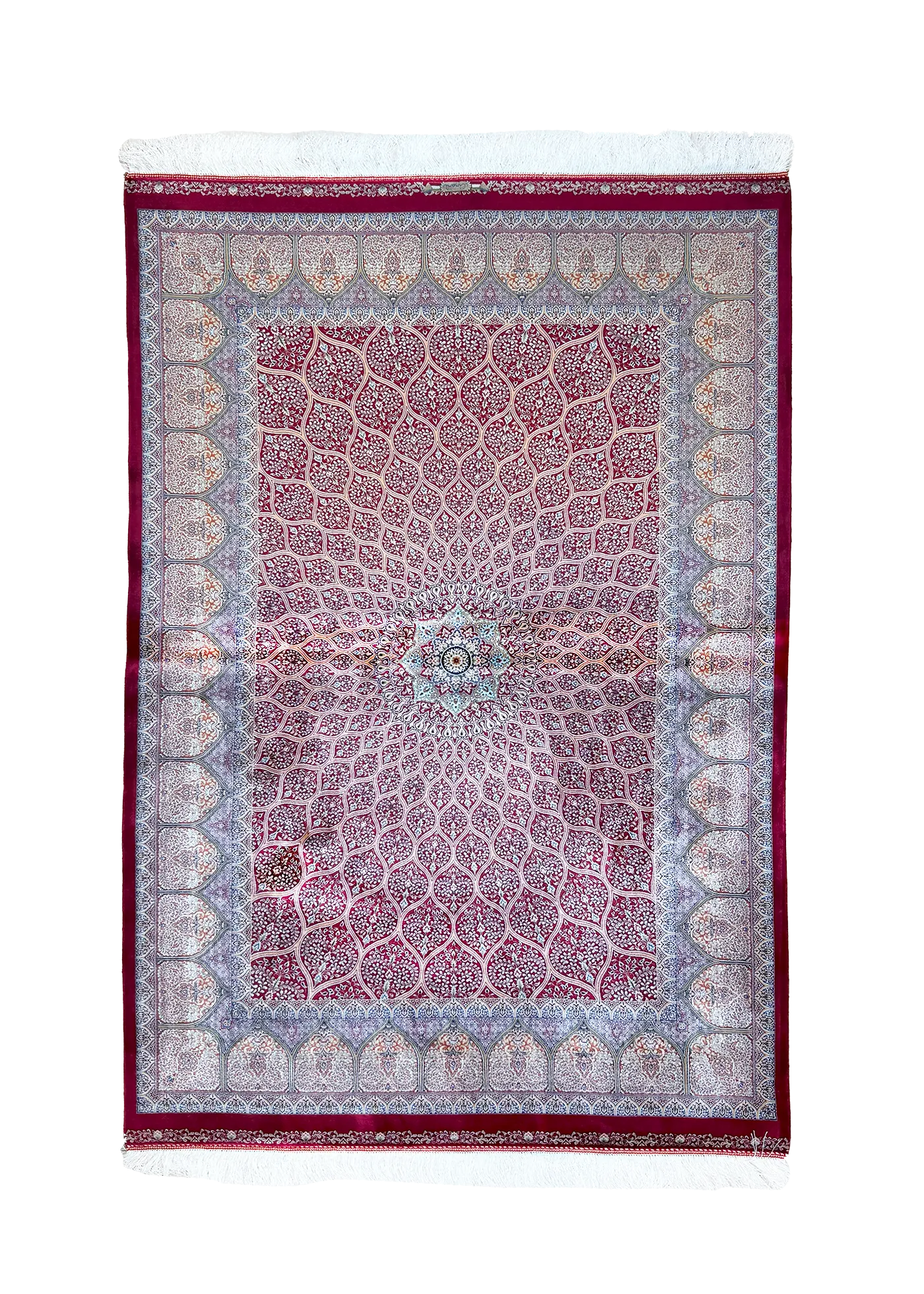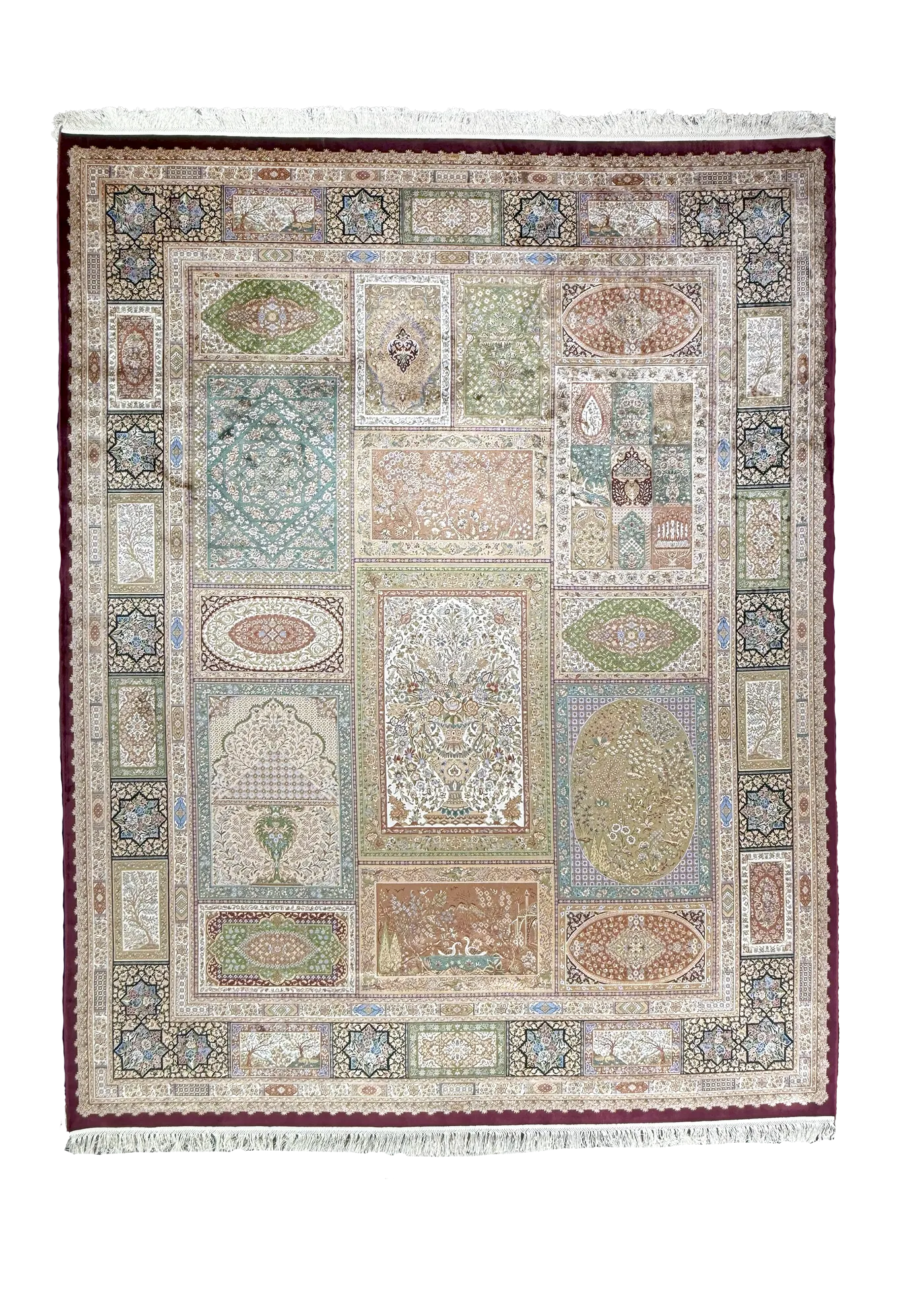Do Persian Rugs Need Pads?

- 1 Red and Blue Persian Rug Vanda Pattern 5 x 8
- 2 The Role of Rug Pads in Protecting Persian Rugs
- 3 How Rug Pads Enhance Comfort and Performance
- 4 Conclusion
Picture this: you’ve just brought home a stunning Persian area rug that transforms your living space into a work of art. Its intricate patterns dance under the light, and every step feels like a journey through history. But as you admire your new large Persian rug, a question pops up—do Persian rugs need pads? I wondered the same thing when I first got my own beautiful rugs inspired by Persian designs.
Trust me, diving into this topic opened my eyes to how much a simple rug pad can do. In this article, we’ll look at why rug pads are important for Persian rugs, how they improve comfort and durability, and what to keep in mind when choosing the right one. We’ll also bust some myths along the way (yes, including how pads can save you money in the long run).
Whether you’ve got a large Persian rug or a smaller area rug, let’s chat about keeping it safe and beautiful for years to come. Curious about your options? Afra Rugs has an amazing selection in our Shop by Size category to fit any space!
The Role of Rug Pads in Protecting Persian Rugs
Let’s start with the basics—why does a Persian area rug even need a pad? Think of a rug pad as a trusty sidekick. It’s not just there to sit pretty; it works hard to protect both your rug and your floors.
Without a pad, your large Persian rug might slip around, especially on slick surfaces like wood floors or tile. That’s not just annoying—it can be a safety hazard.
I learned this the hard way when my rug slid out from under me mid-step. A pad keeps everything in place, so you can walk confidently. But that’s not all—rug pads also shield your wood floors from scratches and dents, especially if your Persian area rug is in a high-traffic spot like a living room.
They act as a buffer, absorbing the pressure from footsteps and furniture. Plus, they help prevent wear on the rug itself by reducing friction between the rug and the floor. House Beautiful says, “A good rug pad can make your rug last longer by stopping extra wear”. That’s great news for your floors and your highest quality rug!
Here’s a quick rundown of why rug pads are a must-have for your Persian area rug:
- Prevents Slipping: Keeps your rug secure, reducing the risk of trips.
- Protects Floors: Stops scratches and scuffs on hardwood or tile.
- Reduces Wear: Less friction means your rug stays vibrant longer.
- Improves Airflow: Helps prevent moisture buildup under the rug.
Look at this gorgeous piece from Afra Rugs—a Blue Silk Persian Rug Horizon 8 x 10 with intricate patterns. Imagine placing this large Persian rug on a hardwood floor without a pad. Those delicate fibers could wear out faster, and your floor might end up scratched. A pad solves both problems in one go.
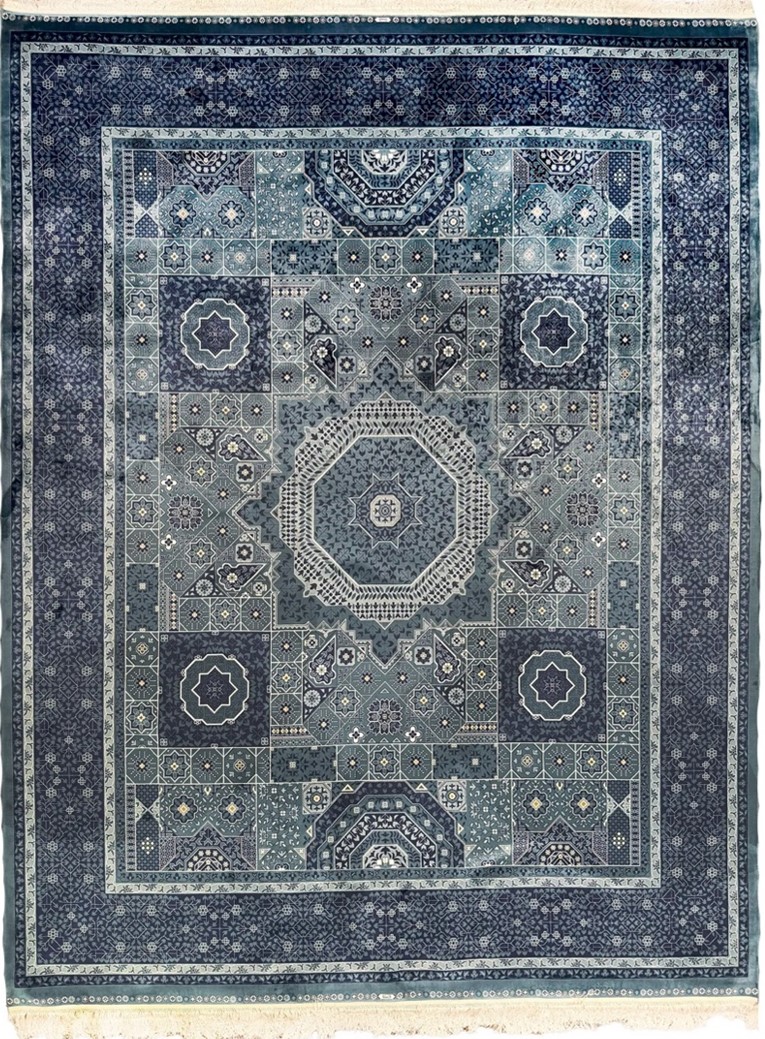
A Blue Silk Persian Rug Horizon 8 x 10 with intricate patterns, perfect for a large Persian rug setup on wood floors. Credit: Afra Rugs.
How Rug Pads Enhance Comfort and Performance
Now that we know rug pads protect, let’s talk about how they make your Persian area rug feel even better. Ever stepped onto an area rug that feels a little thin or flat? A rug pad adds a layer of cushioning that makes every step softer. It’s like giving your large Persian rug a cozy hug from underneath.
Beyond comfort, rug pads improve how your Persian rugs perform day to day. They help the rug lay flat, preventing those annoying curled edges that can trip you up.
They also absorb sound, which is a bonus if you live in an apartment or have wood floors that echo. Elle Decor notes, “Rug pads add an extra layer of soundproofing, making your space feel quieter and more serene” (Elle Decor, “Benefits of Rug Pads,” https://www.elledecor.com/benefits-rug-pads). That’s perfect for creating a peaceful vibe with your Persian area rug.
Another perk? Rug pads make cleaning easier. Without a pad, dirt can grind into the rug’s fibers as it rubs against the floor.
A pad lifts the rug slightly, reducing that friction and keeping it cleaner for longer. For a large Persian rug in a busy space, that’s a game-changer. You’ll spend less time vacuuming and more time enjoying your beautiful rugs.
Let’s admire another Afra Rugs beauty: the Blue and Beige Silk Persian Rug Harmony Pattern 7 x 9, with its modern rustic design. A rug pad under this large Persian rug not only enhances comfort but also keeps those delicate patterns looking pristine.
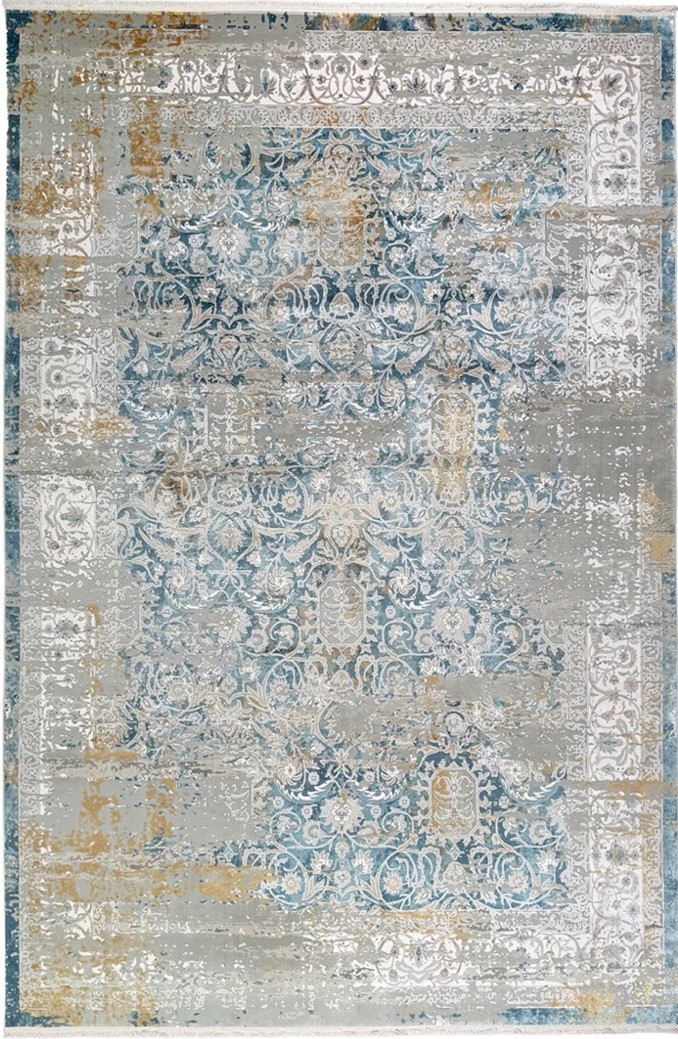
A Blue and Beige Silk Persian Rug Harmony Pattern 7 x 9 with floral motifs, ideal for a large Persian rug with a pad on wood floors. Credit: Afra Rugs.
Choosing the Right Rug Pad for Your Persian Area Rug
So, you’re sold on getting a rug pad for your Persian area rug—but which one should you pick? Let’s break it down. Rug pads come in different materials, like felt, rubber, or a combo of both, and each has its strengths.
Felt pads add cushioning and are great for comfort, while rubber pads grip the floor to prevent slipping. Some pads combine both for the best of both worlds, making them ideal for oriental rugs like yours.
The size of your large Persian rug matters too. For an 8 x 10 Persian area rug, you’ll want a pad that’s slightly smaller—about 2 inches less on each side—so it doesn’t peek out. For a 7 x 9 rug, the same rule applies.
Also, consider the thickness. Thicker pads offer more cushioning but might raise the rug too high, making doors hard to open. A thinner pad works better for low-clearance spaces.
Here’s a handy table to help you choose the right rug pad for your Persian area rug:
| Rug Pad Type | Best For | Benefits | Best for Persian Area Rugs? |
| Felt | Hardwood floors, comfort | Adds cushioning, protects floors | Yes, for extra softness |
| Rubber | Tile or slick surfaces | Prevents slipping, durable | Yes, for safety |
| Felt-Rubber Combo | Versatile use | Combines cushioning and grip | Ideal for most Persian area rugs |
| PVC | Budget-friendly | Basic grip, less cushioning | Not ideal—can discolor floors |
Table: Choosing the Right Rug Pad for Your Persian Area Rug.
When picking a pad, think about your space. If your large Persian rug is in a living room with kids or pets, a rubber-backed pad might be your best bet for safety. In a quieter space like a bedroom, a felt pad can add that extra plush feel. Either way, a good pad ensures your Persian area rug stays in top shape, just like the finest oriental rugs.
Common Myths About Rug Pads and Persian Rugs
Let’s tackle some myths about rug pads and Persian area rugs—because there’s a lot of confusion out there! First up: “Rug pads ruin the look of a large Persian rug.” I used to worry about this too, thinking a pad might make my rug look bulky.
But here’s the truth—pads are designed to be discreet. They hide under the rug, so no one even knows they’re there. Plus, they help the rug lay flat, which actually makes it look better.
Another myth: “You don’t need a pad if your rug is heavy.” Sure, a large Persian rug might feel stable, but weight doesn’t stop it from slipping on a slick floor. I’ve seen even the heaviest Persian rugs slide without a pad, especially with daily foot traffic. A pad ensures safety, no matter the rug’s weight.
Now, let’s talk cost-effectiveness, since you asked about that. Some folks think, “Rug pads are an extra expense I don’t need.” But let’s flip that—pads can save you money in the long run.
Without a pad, your Persian area rug wears out faster from friction, meaning you’ll need to replace it sooner. A pad extends its life, so you’re not shelling out for a new highest quality rug every few years.
Plus, it protects your floors from damage, saving you from costly repairs. Domino puts it well: “A rug pad is a small investment that pays off by preserving your rug and floors” (Domino, “Why You Need a Rug Pad,” https://www.domino.com/why-need-rug-pad).
Finally, some believe rug pads trap dirt. Not true! Pads actually make cleaning easier by lifting the rug off the floor, preventing dirt from grinding in. So, don’t let these myths stop you from giving your Persian area rug the protection it deserves.
FAQ: Your Questions About Rug Pads for Persian Area Rugs
- Do Persian area rugs require specific rug pads?
Not necessarily, but it’s best to choose a pad that suits your floor type and rug size. For a large Persian rug, a felt-rubber combo pad works well for both comfort and grip.
- Can I use a rug pad with a large Persian rug on carpet?
Yes, but opt for a thinner pad to avoid adding too much height. It’ll still help with stability and wear prevention for your area rug.
- How often should I replace a rug pad under my Persian area rug?
Most pads last 5-10 years, but check for wear like thinning or crumbling. Replace it if it’s not providing enough grip or cushioning.
- Will a rug pad damage the fibers of my Persian area rug?
No, a good-quality pad protects the fibers by reducing friction with the floor, helping your beautiful rugs last longer.
Infographic: Guide to Rug Pads for Persian Area Rugs
Here’s a quick visual guide to choosing the right rug pad for your Persian area rug. It covers pad types (felt, rubber, combo), their benefits (cushioning, grip, durability), and tips for matching them to your large Persian rug size.
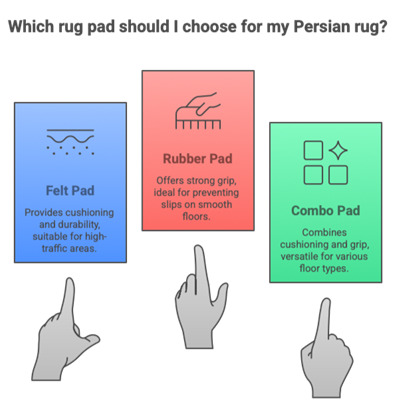
Infographic: Guide to Rug Pads for Persian Area Rugs by Afra Rugs.
Bonus: Care Tips for Your Persian Area Rug Beyond Pads
Since you asked for extra care tips, let’s keep your Persian area rug looking its best! Vacuum gently once a week to remove dust—use a low-suction setting to protect the fibers. If you spill something, blot (don’t rub!) with a clean cloth and mild soap.
Rotate your large Persian rug every six months to even out wear from sunlight and foot traffic. And if you’re storing it, roll it up (don’t fold) and keep it in a dry, cool place to avoid moisture damage. These simple steps will keep your beautiful rugs stunning for years.
Conclusion
So, do Persian rugs need pads? Absolutely—they’re a small addition that makes a big difference. From protecting your wood floors to adding comfort and extending the life of your large Persian rug, a rug pad is a must-have for any area rug.
We’ve covered how they work and how to choose the right one for your space. We also busted some myths (yes, they’re cost-effective too!). Plus, with a few extra care tips, your Persian area rug will stay as beautiful as the day you got it.


